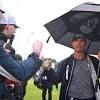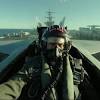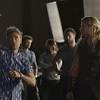The Substance : A Star Is Reborn

AC recently connected with Kračun to discuss the project.
American Cinematographer: This is an unconventional horror movie, to say the least. Are you a fan of the genre?
Benjamin Kračun, BSC: I enjoy horror films. I may not be a fanatic, but horror has always been there for me. I was a very big cinephile as a kid, and I was obsessed with early David Cronenberg and John Carpenter.
What did you think when you first read the script? This seems like an incredible gift for a cinematographer.
I’d seen Revenge and was a big fan, so when the script came to me, I read it straight away. It was so precisely written and thought out, and so fun. It’s completely out there. The last 30 pages were bonkers. I was like, ‘I have to get involved in this.’ It’s 150 pages, and I think only 20 of those have dialogue. It was a gift for every department, from cinematography to production design to prosthetics and visual effects.

The story is set in L.A., but the locations are hard to identify, and there’s a striking, dreamlike quality.
That was the intent. Coralie wanted to shoot it all at Studios d’Epinay, the famous old studio where Cocteau shot Beauty and the Beast. She kept telling me, ‘It’s an L.A. of the mind,’ and I was really excited about that whole concept. When I joined the production in 2022, LED-screen technology was advancing very fast. We had to decide whether we were going to spend an inordinate amount of money on LED screens or go for a classic soft drop, which is also quite a lot of money. I started looking at LED screens in Paris, and firstly, they’re just so expensive. Also, it’s very technical … but was it the right look for The Substance? We weren’t making a technical sci-fi film. We wanted something unique for our film — timeless. I suggested we go to a set where there’s a soft drop and look at it. And although it’s much more rudimentary compared to LED, there was something romantic about it — something filmic, a nod to Hitchcock, to older movies. Coralie really liked that. This is a horror film, and it’s full-on body horror and a gore fest — but, in a weird way, the guide for some of the texture and camera choices was a more romantic look.

Tell us more about those choices. What were other considerations during prep?
The prep was three months and very thorough, [due to the construction of] the sets. We had to come up with the huge panoramic window, the bathroom, the secret room and the long corridor, and it’s almost like each room is another location. I knew Coralie loved close-ups, and she loves for a shot to develop. When she’s describing shots, she’ll use her iPhone and we’ll both move around a room to try and work it out. I could tell that a lot of the shots were going to be dynamic, possibly spinning around and moving in at the same time.
I love anamorphic, and I’ve shot my last three movies anamorphic, but when I started to watch what Coralie was describing, I realized this couldn’t be an anamorphic movie because of all the close-up work. You can only go so close with anamorphic. So, I went to RVZ in Paris and tested all the spherical lenses they had, and I chose the Canon K-35s, rehoused by TLS. They’ve got a warm flare I really wanted — I wanted to get away from a cold, techie vibe. They have a remarkably close focus for vintage glass, and you can also build them out with other lens sets, so you can get very wide. We also used Angenieux Optimo zooms, 36-435mm and 22-60mm; a Leitz Thalia 24mm; Cooke FF 60mm and 90mm macro; Arri Macro 100 and 200mm [1:1]; and a Leitz M 0.8 for body-cam work.
I’ve shot predominantly on Arri Alexa, but I did test [other cameras] and the Alexa side by side. A big thing, of course, is that the film is about beauty and skin, and I knew I was going to be photographing a lot of that. And in a beautiful way, the Alexa sensor had the cleanest and most natural skin look. In the end, we shot 2.39:1 with the Alexa Mini LF, and also used Red V-Raptor and Komodo — the Raptor for VFX shots, with its 8K sensor, and the Komodo for our body and helmet rig.


Did you develop many LUTs in prep?
We worked with Fabien Pascal, a superb colorist, at Lux in Paris. It was quite crucial, actually — Coralie, Fabien and I wanted to create a timeless LUT. It started with building a LUT from the hair-and-makeup test, and we ended up somewhere between a Kodachrome LUT, 25 percent, and an Ektachrome LUT, 75 percent. This combination created deeper reds and warmer tones, while retaining the rich colors of the set design and costumes. In the lower end of the LUT, we did lose a stop and a half of light, but it meant that the blacks came out very deep and silky.
That was our base LUT, but when we filmed the substance fluid that’s injected, it was coming up more orange and it was supposed to be bright fluorescent green. So, during shooting, Fabien made other versions of the LUT: one for filming the fluid, and one for when Elisabeth is wearing her yellow jacket. This LUT was based on the first LUT, but made certain colors more vivid.
The third LUT we had was for the Pump It Up [workout show] and Sue’s TV appearance; it combined the Ektachrome LUT with the Arri Look LUT. We wanted a more modern image for those sequences while still retaining the visual identity of the whole film.

How did Coralie work with you on set?
We had two cameras, but she doesn’t like to shoot two cameras simultaneously — she likes to leapfrog between the two. That way, we could always have one camera going ahead to set for the next shot. One was set mostly on an Arri Trinity; I knew from our discussions she was going to really like that system. The other camera was in studio mode, on a dolly, or on an approximately 13-foot Octojib. So, we had the two units, and then we’d add things when we did any of the larger effects and the big sequences.
My main crew was gaffer Guillaume Lemerle, focus puller Marie-Sophie Daniel, key grip Thomas Gros, B-camera/Trinity operator Benjamin Groussain and DIT Baptiste Marnière. Focus pullers for the B-camera were Laure Caniaux and Stella Libert. I operated the A-camera, unless it was on the Trinity.
Coralie had designed how she wanted to shoot the movie, as she was also producing and editing it, and it was quite an unconventional plan. I was shooting for about 100 days, which seems like a massive amount of time, but it wasn’t 100 days with the full team. The shoot had four elements: the main studio shoot; the interior-locations shoot in Paris with a slightly reduced unit; exteriors in Nice and Cannes to sell the L.A. look with a more reduced unit; and then three weeks at the end for all the close-up work, which was just me, Coralie, one camera assistant, one lighting assistant and one art-department person.

The sequence where Elisabeth ‘gives birth’ to Sue is striking. How did you approach it?
That was the scene I started testing very early on because we had the double-bathroom situation, and Sue is in the other bathroom and I’m essentially her POV, she is her reflection, and we’re mimicking each other. We would sync up my operating with her movements. That was made up of something like seven shots: It starts on the floor, and that shot then goes around to the mirror, it becomes like a POV, you go into the eye, out of the eye and come all the way back as she stands naked in front of the mirror. So, as you move in, you’re going into 24mm [1:4] macro, 100mm [1:1] macro, 200mm macro and a Laowa probe into the eye, and then there’s a tunnel of light — another thing I continually tested. At first, we wondered if we should drop a camera from a wire and have lights on stands. In the end, it was a very simple solution: Imagine you have two tires, you put them on their side, you put the lights around them, spin them and have the camera in the center. That gives you a version of an infinity tunnel.


How did you approach the blood-drenched denouement in the theater?
That was a massive undertaking. We had to build that theater just so we could destroy it. Coralie said at one point, ‘I want to have fire engines full of blood spraying the audience,’ and I thought, ‘Oh, maybe that’s just a French way of saying there’s going to be a lot of blood,’ but no, she really wanted a hose full of blood in the audience, in the theater, and it was going to be a lot of blood! When you’re building and lighting that, it all has to be waterproof, of course. I used Robe iSpiider and iPointe moving lights, mixed with Creamsource Vortex8s and 4s, which are also waterproof. At one point, I took one of the cameras that we’d put in a splash bag and went into the audience dressed in a black suit to blend in with the crowd, and to not be spotted by other cameras. Coralie was operating the hose with all the blood, and she just started pointing it at me and firing it off. That was kind of amazing!

What was your focus in the final grade at Lux?
When we projected it at 4K for the first time, it was insane — just really sharp, really crisp and way too detailed. So, Lux reprocessed it all from 4K back to 2K and back again, to retain the softness we found on set, which was amazing. When Sue is on the TV show, we left that footage at the original 4K so it has a much sharper, ‘hyper’ look.
Making this movie is the hardest thing I’ve ever done, but also the most rewarding. Coralie pushes you to your very limit creatively and technically, and that goes for everybody involved in the film. It really makes you come up with all these new techniques and ideas, and in that way it’s so magical. I loved working with her. She thinks very visually, and her mind works in a four-dimensional kind of way. She’s really, really thoughtful, and I could tell when she was going through shots and blocking that she comes from a pure cinema background. That’s something I could relate to. Even though we didn’t discuss that in direct ways, I think we just spoke in a very similar way.


 Australia
Australia Argentina
Argentina  Austria
Austria  Brazil
Brazil  Canada
Canada  Germany
Germany  Ireland
Ireland  Italy
Italy  Malaysia
Malaysia  Mexico
Mexico  New Zealand
New Zealand  Poland
Poland  South Africa
South Africa  United Kingdom
United Kingdom  United States
United States 






















